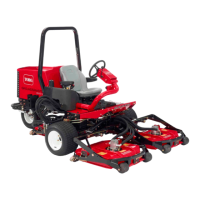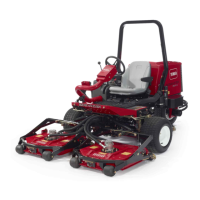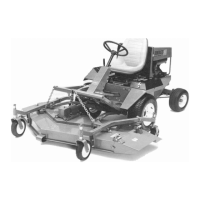Groundsmaster 3500Page 6 − 28Electrical System
5. If fuel pump does not operate or pressure is low, test
the pump while supplying power directly, bypassing the
engine ECU and PWR relay.
A. Disconnect fuel pump electrical connector.
B. Connect a jumper from the A (+) terminal of the
pump connector (red wire) to the mating A (+) termin-
al of the wire harness connector.
C. Connect the B (−) terminal at the pump connector
(black wire) to an engine or chassis ground.
D. Repeat step 4.
If fuel pump pressure is low and power supply to the
pump has been verified, consider a clogged fuel filter or
faulty fuel pump.
6. After testing is completed, remove pressure gauge
from fuel supply hose. Connect fuel supply hose to en-
gine fuel rail and secure with hose clamp.
Fuel Pump Specifications
Pump Capacity
45 fl oz/min (1.3 Ltr/min)
Pressure 43.5 psi (300 kPa)
Max. Current Draw 4.4 amp
Fuel Stop Solenoid (Diesel Engine Only)
The fuel stop solenoid used on the Groundsmaster
3500−D must be energized for the diesel engine to run.
The solenoid is mounted to the injection pump on the en-
gine (Fig. 36).
The fuel stop solenoid includes two coils for operation,
the pull coil and the hold coil. When the ignition switch
is turned to START, the solenoid is initially energized
and the pull coil retracts the solenoid plunger. Once the
plunger is retracted, the hold coil will keep it retracted for
continued engine operation. When the solenoid is de−
energized, the plunger extends to shut off fuel supply to
the engine causing the engine to stop running. The fuel
stop solenoid is grounded through the solenoid housing.
NOTE: Refer to Chapter 9 − Foldout Drawings in this
manual when troubleshooting the fuel stop solenoid.
Testing
NOTE: Prior to taking small resistance readings with a
digital multimeter, short the test leads together. The me-
ter will display a small resistance value (usually 0.5
ohms or less). This resistance is due to the internal re-
sistance of the meter and test leads. For accurate test
results, subtract this value from the measured value of
the component you are testing.
1. Make sure ignition switch is in the OFF position. Dis-
connect wire harness connector from stop solenoid.
2. Using a digital multimeter, touch one test lead to the
pull coil terminal and the other test lead to the stop sole-
noid frame (ground) (Fig. 37). The resistance of the pull
coil should be less than 1 ohm (but not zero).
1. Fuel stop solenoid 2. Harness connector
Figure 36
2
1
1. Fuel stop solenoid
2. Pull coil terminal
3. Hold coil terminal
Figure 37
2
3
1
3. Using a digital multimeter, touch one test lead to the
hold coil terminal and the other test lead to the fuel stop
solenoid frame (ground) (Fig. 37). The resistance of the
hold coil should be approximately 15.5 ohms.
4. Reconnect solenoid to the wiring harness.

